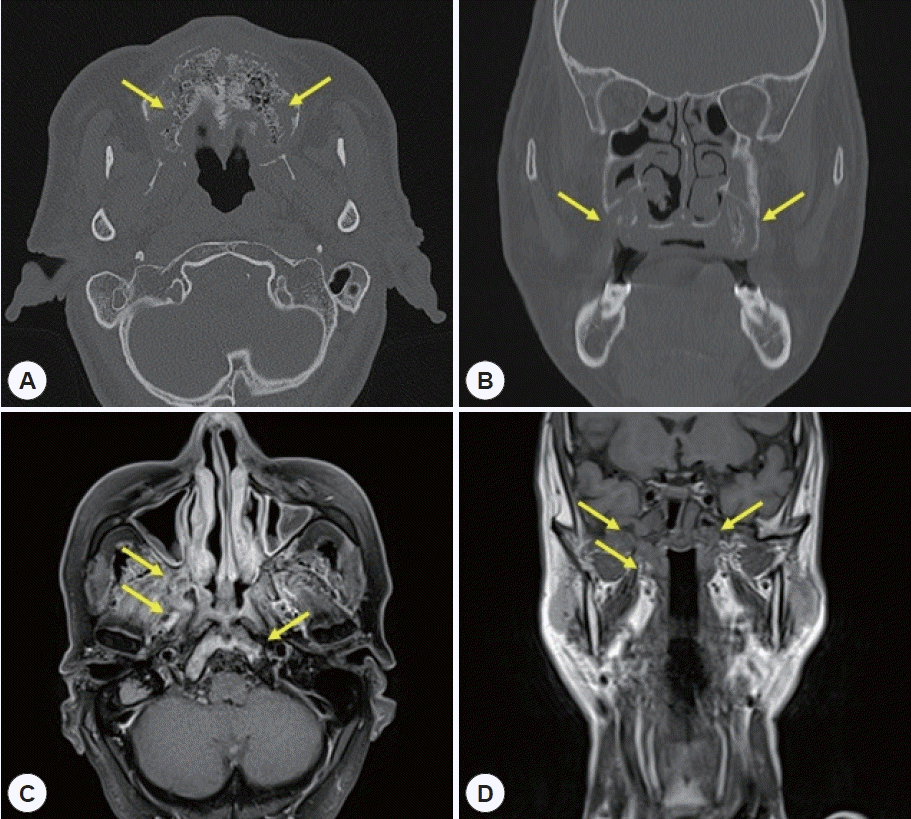1. Prasad KC, Prasad SC, Mouli N, Agarwal S. Osteomyelitis in the head and neck. Acta Otolaryngol. 2007; 127(2):194–205.
2. Khan MA, Quadri SAQ, Kazmi AS, Kwatra V, Ramachandran A, Gustin A, et al. A Comprehensive Review of Skull Base Osteomyelitis: Diagnostic and Therapeutic Challenges among Various Presentations. Asian J Neurosurg. 2018; 13(4):959–70.
3. Singh A, Al Khabori M, Hyder MJ. Skull base osteomyelitis: diagnostic and therapeutic challenges in atypical presentation. Otolaryngol Head Neck Surg. 2005; 133(1):121–5.
4. Cavel O, Fliss DM, Segev Y, Zik D, Khafif A, Landsberg R. The role of the otorhinolaryngologist in the management of central skull base osteomyelitis. Am J Rhinol. 2007; 21(3):281–5.
5. Sie KC, Glenn MG, Hillel AH, Cummings CW. Osteomyelitis of the skull base, etiology unknown. Otolaryngol Head Neck Surg. 1991; 104(2):252–6.
6. Shama SA. Osteomyelitis of the central skull base: Otogenic and odontogenic sources. Multidetector CT study. The Egyptian Journal of Radiology and Nuclear Medicine. 2012; 43(4):519–26.
7. Adams JR, Bryant DG. Cranial osteomyelitis: a late complication of a dental infection. British Journal of Oral and Maxillofacial Surgery. 2008; 46(8):673–4.
8. Sokołowski J, Lachowska M, Karchier E, Bartoszewicz R, Niemczyk K. Skull base osteomyelitis: factors implicating clinical outcome. Acta Neurol Belg. 2019; 119(3):431–7.
9. Medvedev G, Palacios E, Jones W. Iatrogenic occipital osteomyelitis. Ear Nose Throat J. 2009; 88(1):720–1.
10. Adams JR, Bryant DG. Cranial osteomyelitis: a late complication of a dental infection. Br J Oral Maxillofac Surg. 2008; 46(8):673–4.
11. Clayman GL, Adams GL, Paugh DR, Koopmann CF Jr. Intracranial complications of paranasal sinusitis: a combined institutional review. Laryngoscope. 1991; 101(3):234–9.
12. Johnson AK, Batra PS. Central skull base osteomyelitis: an emerging clinical entity. Laryngoscope. 2014; 124(5):1083–7.
13. Blyth CC, Gomes L, Sorrell TC, da Cruz M, Sud A, Chen SC. Skull-base osteomyelitis: fungal vs. bacterial infection. Clin Microbiol Infect. 2011; 17(2):306–11.





 PDF
PDF Citation
Citation Print
Print




 XML Download
XML Download